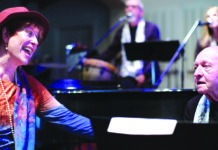On Saturday June 25, a group of Culver City residents celebrated the opening of the beautiful improvements to the Ballona Creek bike path at Overland Avenue, while at City Hall, another group of residents gave input on $1.5 million in grant projects to make it safer for kids to walk and bike to La Ballona and Farragut Elementary Schools, and Culver City Middle and High schools.
The Ballona Creek opening was a great success as community members, environmental advocates, city staff, Mayor Mehaul O’Leary, Assemblywoman Holly Mitchell and Ballona Creek Renaissance President Jim Lamm came together to applaud the completion of this long-anticipated project. Part of the larger Creek Master Plan, this shovel-ready project lacked funding until Federal stimulus money was granted Culver City last year. Spanning 1,000 feet, the revamped section features an artist-designed wrought-iron gate, repaved bicycle path, separated walk path, lighting, an emergency call box, educational signage and newly planted garden that not only beautifies the creek with native plants but serves as a natural filter for storm run-off, protecting the Ballona Creek watershed.
After leading a ride from Town Plaza to the Overland ceremony, the Culver City Bicycle Coalition partnered with Ballona Creek Renaissance to lead a second ride to explore the other improvements and ongoing projects along La Ballona Creek. The weather was perfect, the participants were content and feelings of accomplishment and hope abounded.
On the same day, another bike and pedestrian improvement plan was slowly being trampled. Three workshops were held at City Hall to gather public input for proposed safety improvements in neighborhoods surrounding the tri-school complex (Farragut Elementary School, Culver City Middle School and Culver City High School) and La Ballona Elementary for a Federal grant application. The city was seeking input to help refine and shape the projects it would include in its Safe Routes To School (SRTS) grant proposal. While less than 30 people attended the three workshops, there was negative feedback from a few individuals who felt the project included changes that were undesirable for the neighborhood and that the public input process had moved too quickly (the grant is due July 15). After complaints were received at City Hall, the grant application was halted. Now the potential for $1.5 million worth of improvements is on indefinite hold in areas that have been subject to years of traffic nightmares, at least two car accidents involving schoolchildren in the past two years, and countless complaints from area residents.
The plan includes:
- Improved crosswalks to create higher visibility pedestrian crossings
- Curb extensions throughout the area to reduce pedestrian crossing distances and slow vehicles
- New bike lanes and separated bikeways to provide safer areas for children to ride to and from school
- More visible signage to create more awareness for pedestrians and cyclists
- Additional stop signs and traffic signals to slow and control traffic
- New on-campus secure bike parking for students
- Changes to parts of Elenda Street from a high-speed 40-feet-wide boulevard to a 20-feet-wide one-way street near Culver City Middle School to control traffic and create a safer route for drop offs and pickups
The proposed improvements were the direct result of public input. In May, the city hosted a day-long workshop on the SRTS program with stakeholders from the four schools, including area residents, teachers, parents, police and fire department representatives, city engineers and public health officials. The room was filled to capacity. Attendees repeated over and over that traffic and safety conditions at the schools are unacceptable and need to be addressed as soon as possible, often citing the morbid proof that two children had been hit by cars in front of these schools in the past two years.
Working together, all the different stakeholders at the workshop drew on maps, highlighting the problem areas, making suggestions and finding solutions. Then the SRTS consultant spent weeks studying the areas and consulting with engineering and public works before drafting the proposals presented at the workshops last Saturday.
Though time was short, city staff sought this specific grant because it would save the city considerable money while bringing long-demanded improvements to these two key neighborhoods. The grant requires no matching funds from the city (whereas most grants require the city’s financial participation), and the consultant used to prepare the grant had been paid for by Los Angeles County Public Health (which also funded the Culver City Bicycle and Pedestrian Initiative). This Federal SRTS grant opportunity will not present itself any time soon, as it appears every two to three years on average, in an irregular cycle. Furthermore, the L.A. County Public Health-funded consultant was a one-time offer. This unique convergence of financial incentives is now, it seems, lost.
However, as of the writing of this article, the coalition has a glimmer of hope: The residents and parents of La Ballona Elementary students have embraced the plan and are rallying around the proposed improvements, hoping to convince the city to let their part of the project survive.
Bike Safe, Bike Smart! is a weekly column to promote responsible cycling by providing information, education and advice about riding. It’s written by members of the Culver City Bicycle Coalition (CCBC), a local chapter of the Los Angeles County Bicycle Coalition. The CCBC hosts a family ride each month. For more information, go to ccbike.org.













